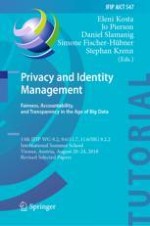2019 | OriginalPaper | Buchkapitel
Data Protection by Design for Cross-Border Electronic Identification: Does the eIDAS Interoperability Framework Need to Be Modernised?
verfasst von : Niko Tsakalakis, Sophie Stalla-Bourdillon, Kieron O’Hara
Erschienen in: Privacy and Identity Management. Fairness, Accountability, and Transparency in the Age of Big Data
Aktivieren Sie unsere intelligente Suche, um passende Fachinhalte oder Patente zu finden.
Wählen Sie Textabschnitte aus um mit Künstlicher Intelligenz passenden Patente zu finden. powered by
Markieren Sie Textabschnitte, um KI-gestützt weitere passende Inhalte zu finden. powered by
